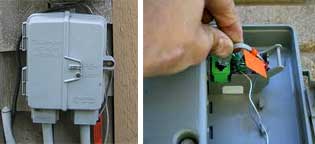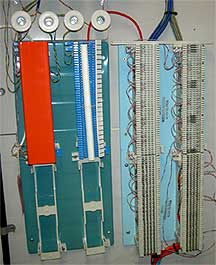|  | 
| What is the demarcation point? |
|
The demarcation point, or
demarc, is the point at which the telephone company's wiring ends and
the customer's wiring begins. This point may vary depending on
what country you are in, but in the U.S. the demarc is typically on the
customers premise. For businesses, a large
punch down block typically exists inside the building perimeter. while for
residences, a junction box is located on the outside of the house.
|
| Residential Demarc |
 |
|
|
| |
| The history behind the demarc |
| The American
Telephone & Telegraph Company (AT&T Corporation) was founded in 1886. As
AT&T expanded, it evolved into a natural monopoly for telephone service
within the United States. Through numerous acquisitions and
technological innovations, AT&T grew so large that it even owned the
local loop, which included the customers' wiring and telephone
equipment.
The 'natural monopoly' status did not sit
well with the United States, and in 1956 lawsuits ensued. Some
felt that AT&T had become too powerful and that it should not be allowed
to retain this status. In 1974 the United States Department of Justice
filed an antitrust suit against AT&T. The United States v. AT&T suit
continued until a settlement was reached on January 8, 1982. The
settlement, known as the Modified Final Judgment (MFJ), forever changed
the telecommunications industry. |
| Commercial or
Business Demarc |
 |
|
|
|
Effective January 1, 1984, the MFJ required AT&T
to dissociate from its local exchange service operating companies. These
local operations were split into seven independent Regional Bell Operating
Companies (RBOCs), which were required to provide equal access to AT&T
competitors. Companies were also able to sell third-party equipment that
would connect to the PSTN and American consumers now had the ability to
purchase telephones without going through AT&T.
 Because
consumers could now own their phone systems (as opposed to leasing them
from AT&T) there needed to be a way to delineate that portion of the network
which was owned by the customer and the portion owned by the Telephone
Company. The dividing line, or meeting point, is now known as the demarcation point. Because
consumers could now own their phone systems (as opposed to leasing them
from AT&T) there needed to be a way to delineate that portion of the network
which was owned by the customer and the portion owned by the Telephone
Company. The dividing line, or meeting point, is now known as the demarcation point.
Today, the Telephone company services the
network up to and including the demarc. Any lines and equipment
located beyond the demarc are the responsibility of the customer. This
allows consumers to choose a phone system from a variety of third party
manufacturers and connect to the PSTN. |
|
|